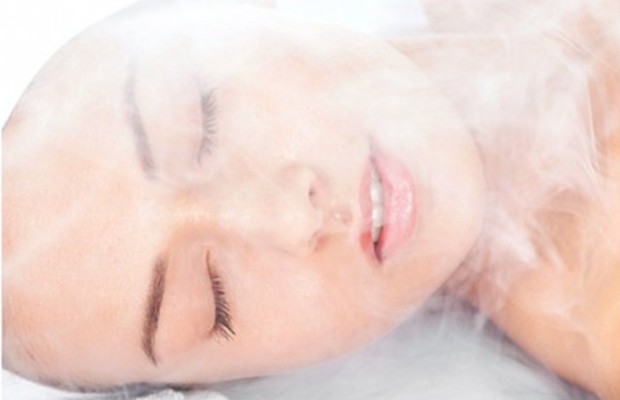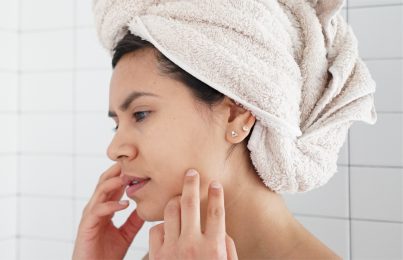Updated 3/17/18. Who doesn’t like a nice steam or sauna experience? I know I do! While the warmth encompasses your body and can provide relaxation, how does a sauna or a steam room affect the skin on the face? Does it provide any benefit? From a beauty standpoint, there are pros and cons for how either a steam room or a sauna can impact the skin. For certain skin types they can be good for the skin, but for other types of skin, it actually may be doing more harm than good. In this post, I’ll go into the details of all.
- What’s happening to the skin while in a steam room?
- What are the benefits to the skin from a steam room?
- How can steam be bad for the skin?
- Does steam open up the pores?
- What’s happening to the skin while in a sauna?
- What are the benefits to the skin from going into a sauna?
- How can a sauna be bad for the skin?
First, let’s start with steam.
What’s happening to the skin while in a steam room?
- Humidity that is given off from the steam is providing water-based hydration to the top surface layers.
- Since steam rooms typically have temperatures of around 110 degrees, it will help to increase the skins’ internal temperature causing a dilation of capillaries, which stimulates blood circulation. This will result in the skin appearing flushed and red in most skin types.
What are the benefits to the skin from a steam room?
Since humidity of a steam room is at 100%, it makes it quite hydrating to the skin. Skin cells are like fish and need water to live so steam can be very beneficial for keeping surface layers feeling moist and looking healthy—as long as when you leave the steam room you apply a protective moisturizer to the skin to keep the hydration sealed into the skin. Through a process called osmosis, the dry air (like when you walk about of the steam room, made worse in the winter) draws moisture from wherever it can get it and this includes your skin. So if a serum or cream isn’t applied topically within 60 seconds to keep the moisture in the skin, it will evaporate out and the skin will be more dehydrated than even before you went in the steam room.
Another benefit is that of increased circulation that comes with heat. It is through the blood that oxygen and nutrients feed the cells in both our skin and body which are absolutely essential for keeping the metabolism of the cells acting young and making the repair processes function efficiently. All of this slows down with age so I’m a real advocate of stimulating blood flow to the skin. You can read more about the importance of skin circulation to get a glow.
How can steam be bad for the skin?
The drawback of a steam room is the intense heat that it gives off. For certain skin conditions like rosacea, where the skin already has a red appearance and stimulates all too easily, steam will cause a further dilation in capillaries making the skin even redder. So for anyone with a lot of redness and visible capillary damage in their skin (like skin types #5 and #9), a steam room would not be recommended to use on a regular basis. But the good news is, if you do want to enjoy a steam experience, you can always hold an ice-cold washcloth on your face while in the room to keep the internal face temperature regulated. You might also perform a post-steam ice-cold water splash on the face to constrict capillaries and cool down the skin or apply a soothing mask like Bio Calm Repair Masque.
Secondly, for those prone to melasma (dark brown patches on the skin from hormones), the heat may also increase the possibility of making discoloration more prominent since heat inflames the skin, raising the skin’s internal temperature and waking up melanin cells. The goal with any type of pigmentation is to calm over-active melanin cells with soothing anti-inflammatory ingredients like licorice and stable vitamin C and so unnecessarily creating more stimulation of melanin with heat is never a good idea. If you are someone prone to pigmentation and are trying to get it to fade, an important goal is to keep the temperature of the skin as cool as possible so this would mean avoiding being outdoors on extremely hot days, steam rooms, sauna, and hot yoga.
Does steam open up the pores?
As an esthetician, I know that steam is considered an important step in a facial to warm up the skin, soften the debris within the pores to prepare for easier removal of blackheads and provide hydration. But much to the surprise of many, heat doesn’t actually open up the pores so, in a steam room, there is no cleansing occurring in this way.
Let’s now talk about a sauna.
Before I go into it further, I actually have a lot of personal experiences with saunas as my mom’s side of the family is from Finland where many don’t even have showers but instead use saunas for bathing. My childhood summers were spent at our cabin with my Finnish grandparents where we didn’t have running water and we used saunas. My grandfather would start the wood fire underneath the sauna in the early afternoon to heat up the rocks inside so before dinner, we would all get clean. We collected rainwater in barrels and used this to wash our hair and body. I have really great memories of those summer nights spent in the sauna.
What’s happening to the skin while in a sauna?
- A sauna gives off dry heat and there is very little humidity given off from the water being poured onto the hot rocks or heater.
- Since saunas typically have temperatures between 170-212 degrees, this will significantly raise the skins’ internal temperature causing a dilation of capillaries, which increases blood circulation. This will result in the skin getting flushed and red in almost all skin types.
What are the benefits to the skin from going into a sauna?
A benefit is that of increased circulation that comes with heat. It is through the blood that oxygen and nutrients feed the cells in both our skin and body which are absolutely essential for keeping the metabolism of the cells acting young and making the repair processes function efficiently. All of this slows down with age so I’m a real advocate of stimulating blood flow to the skin. (You can read more about the importance of skin circulation to get a glow.)
How can a sauna be bad for the skin?
The drawback of a sauna is that temperatures are much hotter than in a steam room so while they can increase blood circulation and offer the benefits as mentioned above, someone with a lot of redness in their skin should avoid using a sauna altogether. It’s important to note that since heat rises, it won’t be as hot for any type of skin if you sit on one of the lower benches versus the top bench. I remember this all too well from my young sauna days. My sister’s and I would complain about it getting so hot and how we couldn’t breathe and my grandmother was always telling us, “Move to the bottom bench!” And yes, it was much less hot down there.
Also, saunas are a drier heat because the temperatures are between 170-212 degrees making a less humid environment, anywhere from 5-20%. While they will provide a little hydration to the skin, they are considerably less beneficial for hydration than a steam room. Similar to use with a steam room, always apply a moisturizer immediately on the skin afterward to keep the hydration in the skin and prevent evaporation when the air is dry.
Lastly, for those prone to melasma (dark brown patches on the skin from hormones), the heat may also increase the possibility of making discoloration more prominent since heat inflames the skin, raising the skin’s internal temperature and waking up melanin cells. The goal with any type of pigmentation is to calm over-active melanin cells with soothing anti-inflammatory ingredients like licorice and stable vitamin C as found in Vitamin C&E Treatment and so unnecessarily creating more stimulation of melanin with heat is never a good idea. If you are someone prone to pigmentation and are trying to get it to fade, an important goal is to keep the temperature of the skin as cool as possible so this would mean avoiding being outdoors on extremely hot days, steam rooms, saunas, and hot yoga.
In summary, from a hydration standpoint, both steam and saunas are beneficial but there are many topical products that can provide an easier and quicker way to hydrate thirsty skin cells if that’s the goal you’re going for. A hyaluronic acid-based serum like Skin Drink Concentrate or a moisturizer like Glow Enhancing Creme are both excellent for delivering hydration to thirsty skin cells.
I definitely recommend both steam rooms and a sauna for my clients who have skin types that could benefit from a boost of circulation. (Take my Skin Type Quiz.) However, as I said previously, you can always put a cold washcloth over your face to prevent putting pressure on fragile capillaries.
Celebrity Esthetician & Skincare Expert
As an esthetician trained in cosmetic chemistry, Renée Rouleau has spent 30 years researching skin, educating her audience, and building an award-winning line of products. Her hands-on experience as an esthetician and trusted skin care expert has created a real-world solution — products that are formulated for nine different types of skin so your face will get exactly what it needs to look and feel its best. Trusted by celebrities, editors, bloggers, and skincare obsessives around the globe, her vast real-world knowledge and constant research are why Marie Claire calls her “the most passionate skin practitioner we know.”




Comments:
What should choose people with eczema? A sauna or a steam room?
Posted By: Myron Dallas |
Hi! Since there are different types of eczema, it depends on your unique condition. In my experience, a steam room is more beneficial for the skin because it’s less dehydrating, but I recommend consulting with your dermatologist before trying either of these.
Posted By: Renée Rouleau |
Hi – How often should I use steam rooms? or Sauna?
Thanks!
Posted By: Jyo |
As often as you want to.
Posted By: Renée Rouleau |
Hi, how are you? I hope all is well. What about showering after the sauna? How does the shower come into play best with the sauna? I just started going into the sauna and I was showering immediately after to clean the pores and then moisturizing. Then my friend sent me this article. Should I be moisturizing before and after the shower? Your comments and thoughts are welcome when you get a chance please. Thanks!
Posted By: Jennifer |
Hi Jennifer, Great question. Anytime you put water on the skin, you instantly hydrate it, so yes, showering post-sauna is a great idea. You can also dab your skin with a wet washcloth while in the sauna just to keep moisture on the face. Moisturizer post-shower, for sure.
Posted By: Renée Rouleau |